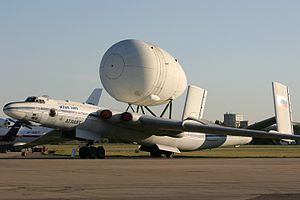Myasishchev WM-T
| Myasishchev WM-T "Atlant" | |
|---|---|
 A Mjasishchev WM-T with a transport container in 2005 |
|
| Type: | Transport plane |
| Design country: | |
| Manufacturer: | |
| First flight: |
April 29, 1981 |
| Commissioning: |
1983 |
| Number of pieces: |
3 (2 airworthy specimens) |
The Mjassischtschew WM-T Atlant ( Russian Мясищев ВМ-E button Атлант ) was a Soviet transport plane for the Buran- and Energia space program, that by means of conversions of the OKB Mjassischtschew developed aircraft bomb MYASISHCHEV M-4 / 3M was realized.
History and construction
After a modification of the Antonov An-22 for the transport of rockets and other large spacecraft to the Baikonur Cosmodrome was considered, Myasishchev was asked to solve this transport problem. When the aircraft called 3M-T (Transporter) was designed in the summer of 1978, the conventional tail unit of the M-4 was replaced by a wide-span horizontal tail unit with a V-position , which received large, rectangular end plates. This arrangement should make it possible to carry payloads up to twice the diameter of the aircraft fuselage. The cargo was transported in a large, aerodynamically optimized container placed on the aircraft. In addition, the aircraft received a new control system to compensate for the additional weight.
For the Mjasishchev 3M-T, three M-4s from the active Soviet long-distance air force were used. The first specimen served as a static break cell, the other two were converted to the airworthy specimens СССР-01402 and СССР-01502 , which were used to transport the central stage of the Energija launch vehicle from the development company to the Baikonur launch site. The Atlant (RA-01402) was equipped with an air refueling probe in order to avoid a stopover for refueling during the cargo transport.
The transport aircraft named after Vladimir Myasishchev's death on October 14, 1978 in his honor of WM-T and after the Greek god Atlant flew for the first time on April 29, 1981 and began flight tests with increasing loads on January 6, 1982.
In the Buran program, two functional models and the first two orbiters were transported to Baikonur on the “Atlant”. The orbiters were not yet completed, heat protection tiles, rudder units, engines, landing gear, etc. were not installed, otherwise the weight would have been too high for transport with the WM-T. Further transports of the orbiters were not planned, as with the completion of the Antonov An-225 Mrija an aircraft was available that could transport fully equipped space shuttles. From 1989 the An-225 took over the tasks of the "Atlant", whereby the aerodynamic rear cover of the Orbiter could be omitted. Ideas to use the WM-T as a flying launch platform for small space gliders were not realized.
Technical specifications

| Parameter | Data |
|---|---|
| crew | 5 |
| length | 51.2 m |
| span | 53.6 m |
| height | 10.6 m |
| Wing area | |
| Wing extension | |
| payload | 50,000 kg |
| Empty mass | 75,740 kg |
| Max. Takeoff mass | 192,000 kg |
| Top speed | 500 km / h |
| Cruising altitude | 8000-9000 m |
| Range | 1500 km |
| Engines | 4 × RKBM / Koliesow WD-7MD turbo jets, each 105.45 kN |
| Thrust-to-weight ratio | 0.224 (at MTOW) |
Whereabouts
Two planes were built. The "Atlant" (RF-01502) owned by ZAGI and LII is at the Zhukovsky airfield , the other (RA-01402) at the Djagilewo air base in Ryazan.
See also
literature
- Bart Hendrikx Bert Vis: Energiya-Buran The Soviet Space Shuttle. ISBN 978-0-387-69848-9
Web links
- History and details of WM-T Atlant
- WM-T with all different payloads
- Aviation.ru
- WM-T at Dyagilevo AFB (google maps)
Individual evidence
- ^ Bill Gunston, Yefim Gordon: The extinct Bison - Part 3 . In: AIR International December 1995, p. 347
- ↑ History and details of the VM-T Atlant
- ↑ Jane's, Rendall 1996, p. 189.